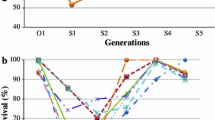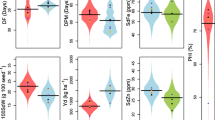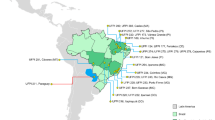Abstract
The germplasm of cultivated common bean exhibits a lower level of genetic diversity within each geographical gene pools (Mesoamerican and Andean) compared to that of the respective wild ancestors. Crosses between these two gene pools potentially provide a source of additional genetic diversity but their progenies have been characterized by phenotypic abnormalities and reduced productivity. In order to gain additional insights into this problem, we examined the segregation for performance in two recombinant inbred populations (RIPs) resulting from Mesoamerican × Andean crosses in three contrasting environments and two years. The two RIPs – ‘California Dark Red Kidney’ (of Andean origin) × ‘Yolano’ (Mesoamerican), n = 150, and A55 (Mesoamerican) × G122 (Andean), n = 67 – were grown in replicated field tests to assess the agronomic performance of each recombinant inbred line. Both populations exhibited, on average, greater days to maturity (DTM), lower biomass growth rate (above-ground dry weight/DTM), lower economic growth rate (seed yield/DTM), and lesser harvest index. In contrast with the conclusions of earlier experiments, there was no evidence from the field trials for a genetic association (due to linkage or pleiotropy) between seed weight and economic growth rate, but there may be a genetic association between seed weight and life cycle length. We compare the results of these studies with earlier experiments on inter-gene pool recombinant populations of common beans and relate our observations of diminished performance to models of speciation mechanisms.
Similar content being viewed by others
References
Ali, M., M. Copeland, S. Elias & J. Kelly, 1995. Relationship between genetic distance and heterosis for yield and morphological traits in winter canola (Brassica napus L.). Theor Appl Genet 91: 118–121.
Beaver, J.S. & J.D. Kelly, 1994. Comparison of selection methods for dry bean populations derived from crosses between gene pools. Crop Sci 34: 34–37.
Debouck, D.G., O. Toro, O.M. Paredes, W.C. Johnson & P. Gepts, 1993. Genetic diversity and ecological distribution of Phaseolus vulgaris in northwestern South Africa. Econ Bot 47: 408–423.
Dobzhansky, T., 1936. Studies on hybrid sterility. II. Localization of sterility factors in Drosophila pseudoobscura hybrids. Genetics 21: 112–135.
Foolad, M.R. & A. Bassiri, 1983. Estimates of combining ability, reciprocal effects and heterosis for yield and yield components in a common bean diallel crosses. J Agri Sci (Cambridge) 100: 103–108.
Freyre, R., R. Ríos, L. Guzmán, D. Debouck & P. Gepts, 1996. Ecogeographic distribution of Phaseolus spp. (Fabaceae) in Bolivia. Econ Bot 50: 195–215.
Gepts, P. & F.A. Bliss, 1985. F1 hybrid weakness in the common bean: differential geographic origin suggests two gene pools in cultivated bean germplasm. J Hered 76: 447–450.
Gepts, P., 1993. The use of molecular and biochemical markers in crop evolution studies. Evol Biol 27: 51–94.
Gepts, P., 1998. Origin and evolution of common bean: past events and recent trends. J Amer Soc Hort Sci (in press).
Ghaderi, A., M.W. Adams & A.M. Nassib, 1984. Relationship between genetic distance and heterosis for yield and morphological traits in dry edible beans (Phaseolus vulgaris) and faba beans (Vicia faba). Crop Sci 24: 37–42.
Gutiérrez, J.A. & S.P. Singh, 1985. Heterosis and inbreeding depression in dry bush beans, Phaseolus vulgaris. Can J Plant Sci 65: 243.
Guzmán, P., R.L. Gilbertson, R. Nodari, W.C. Johnson, S.R. Temple, D. Mandala, A.B.C. Mkandawire & P. Gepts, 1995. Characterization of variability in the fungus Phaeoisariopsis griseola subbests coevolution with the common bean (Phaseolus vulgaris). Phytopathology 85: 600–607.
Johnson, W., C. Menéndez, R. Nodari, E.M.K. Koinange, S. Singh & P. Gepts, 1996. Association of a seed weight factor with the phaseolin seed storage protein locus across genotypes, environments, and genomes in Phaseolus — Vigna spp.: Sax (1923) revisited. J Quant Trait Loci 2: Article 5, http://probe.nalusda.gov/otherdocs/jqtl/jqtl1996–1905/sax1992.htm.
Kami, J.A. & P. Gepts, 1994. Phaseolin nucleotide sequence diversity in Phaseolus. I. Intraspecific diversity in Phaseolus vulgaris. Genome 37: 751–757.
Koenig, R. & P. Gepts, 1989. Allozyme diversity in wild Phaseolus vulgaris: further evidence for two major centers of diversity. Theor Appl Genet 78: 809–817.
Koinange, E.M.K. & P. Gepts, 1992. Hybrid weakness in wild Phaseolus vulgaris L. J Hered 83: 135–139.
Kornegay, J., J.W. White & O.O. De la Cruz, 1992. Growth habit and gene pool effects on inheritance of yield in common bean. Euphytica 62: 171–180.
Laing, D., P. Jones & J. Davis, 1984. Common bean (Phaseolus vulgaris L. ). In: P. Goldsworthy & N. Fisher (Eds), The Physiology of Tropical Field Crops, pp. 305–351. Wiley, New York.
Link, W., B. Schill, A. Barbera, J. Cubero, A. Filipetti, L. Stringi, E. von Kittlitz & A. Melchinger, 1996. Comparison of intra-and inter-pool crosses in faba beans (Vicia faba). I. Hybrid performance and heterosis in Mediterranean and German environments. Plant Breed 115: 352–360.
Lynch, M., 1991. The genetic interpretation of inbreeding depression and outbreeding depression. Evolution 45: 622–629.
Moll, R., J. Lonnquist, J. Vélez Fortuno & E. Johnson, 1965. The relationship of heterosis and genetic divergence in maize. Genetics 52: 139–144.
Muller, H., 1940. Bearing of the Drosophila work on systematics. In: J. Huxley (Ed), The New Systematics, pp. 185–268. Clarendon, Oxford.
Murty, B. & I. Anand, 1965. Combining ability and genetic diversity in some varieties of Linum usitatissimum. Indian J Genet Plant Breed 26: 21–36.
Nienhuis, J. & S.P. Singh, 1986. Combining ability analysis and relationships among yield, yield components and architectural traits in dry beans. Crop Sci 26: 21–27.
Orr, H., 1995. The population genetics of speciation: the evolution of hybrid incompatibilities. Genetics 139: 1805–1813.
Patiño, H. & S. Singh, 1989. Visual selection for seed yield in the F2 and F3 generations of nine common bean crosses. Annu Rept Bean Improv Coop 32: 79–89.
Ramanujam, S., A. Tiwari & R. Mehra, 1974. Genetic divergence and hybrid performance in mung bean. Theor Appl Genet 45: 211–214.
SAS Institute, 1988. SAS/STAT User's Guide, Release 6.03 Edition. SAS Institute, Cary, NC.
Sexton, P., J.White & K. Boote, 1994. Yield-determining processes in relation to cultivar seed size of common bean. Crop Sci 34: 84–91.
Shii, C.T., M.C. Mok, S.R. Temple & D.W.S. Mok, 1980. Expression of developmental abnormalities in hybrids of Phaseolus vulgaris L. J Hered 71: 218–222.
Shonnard, G.C. & P. Gepts, 1994. Genetics of heat tolerance during reproductive development in common bean. Crop Sci 34: 1168–1175.
Singh, S.P. A.J. Gutiérrez, 1984. Geographical distribution of the DL 1 and DL 2 genes causing hybrid dwarfism in Phaseolus vulgaris L., their association with seed size, and their significance to breeding. Euphytica 33: 337–345.
Singh, S.P., C. Cajiao, J.A. Gutiérrez, J. Garía, M.A. Pastor-Corrales & F.J. Morales, 1989. Selection for seed yield in inter-gene pool crosses of common bean. Crop Sci 29: 1126–1131.
Singh, S.P., P. Gepts & D.G. Debouck, 1991. Races of common bean (Phaseolus vulgaris L., Fabaceae). Econ Bot 45: 379–396.
Singh, S.P., R. Nodari & P. Gepts, 1991. Genetic diversity in cultivated common bean. I. Allozymes. Crop Sci 31: 19–23.
Singh, S.P. & C.A. Urrea, 1995. Inter-and intraracial hybridization and selection for seed yield in early generations of common bean, Phaseolus vulgaris L. Euphytica 81: 131–137.
Singh, S.P. & A. Molina, 1996. Inheritance of crippled trifoliolate leaves occurring in interracial crosses of common bean and its relationship with hybrid dwarfism. J Hered 87: 464–469.
Skroch, P. & J. Nienhuis, 1995. Qualitative and quantitative characterization of RAPD variation among snap bean (Phaseolus vulgaris) genotypes. Theor Appl Genet 91: 1078–1085.
Sonnante, G., T. Stockton, R.O. Nodari, V.L. Becerra Velásquez & P. Gepts, 1994. Evolution of genetic diversity during the domestication of common-bean (Phaseolus vulgaris L.). Theor Appl Genet 89: 629–635.
Sprecher, S. & M. Khairallah, 1989. Association of male sterility with gene pool recombinants in bean. Annu Rept Bean Improv Coop 32: 56–67.
Weeden, N.F., 1984. Distinguishing among white-seeded bean cultivars by means of allozyme genotypes. Euphytica 33: 199–208.
Welsh, W., W. Bushuk, W. Roca & S.P. Singh, 1995. Characterizatioin of agronomic traits and markers of recombinant inbred lines from intra-and interracial populations of Phaseolus vulgaris L. Theor Appl Genet 91: 169–177.
White, J.W. & A. González, 1990. Characterization of the negative association between seed yield and seed size among genotypes of common bean. Field Crops Res 23: 159–175.
White, J.W., S.P. Singh, C. Pino, M.J. Ríos B & I. Buddenhagen, 1992. Effects of seed size and photoperiod response on crop growth and yield of common bean. Field Crops Res 28: 295–307.
Xiao, J., J. Li, L. Yuan, S. McCouch & S. Tanksley, 1996. Genetic diversity and its relationship to hybrid performance and heterosis in rice as revealed by PCR-based markers. Theor Appl Genet 92: 637–643.
Author information
Authors and Affiliations
Rights and permissions
About this article
Cite this article
Johnson, W.C., Gepts, P. Segregation for performance in recombinant inbred populations resulting from inter-gene pool crosses of common bean ( Phaseolus vulgaris L.). Euphytica 106, 45–56 (1999). https://doi.org/10.1023/A:1003541201923
Issue Date:
DOI: https://doi.org/10.1023/A:1003541201923




